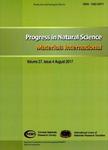Anti-nociceptive role of neuropeptide Y in the nucleus accumbens in rats with inflammation, an effect modulated by mu- and kappa-opioid receptors
Anti-nociceptive role of neuropeptide Y in the nucleus accumbens in rats with inflammation, an effect modulated by mu- and kappa-opioid receptors作者机构:Laboratory of Neurobiology College of Life Sciences Peking University Beijing 100871 China National Laboratory of Biomembrane and Membrane Biotechnology Peking University Beijing 100871 China
出 版 物:《Progress in Natural Science:Materials International》 (自然科学进展·国际材料(英文))
年 卷 期:2006年第16卷第2期
页 面:133-141页
核心收录:
学科分类:0710[理学-生物学] 07[理学] 071006[理学-神经生物学] 0805[工学-材料科学与工程(可授工学、理学学位)] 0702[理学-物理学]
基 金:National Natural Science Foundation of China (Grant No. 30370455)
主 题:nucleus accumbens, neuropeptide Y, Y1 receptor, carrageenan anti-nociception, μ- and κ-opioid receptors.
摘 要:Recent study in our laboratory showed that neuropeptide Y (NPY) plays an antinociceptive role in the nucleus accum-bens (NAc) in intact rats. The present study was performed to further investigate the effect of NPY in nociceptive modulation in the NAc of rats with inflammation, and the possible interaction between NPY and the opioid systems. Experimental inflammation was induced by subcutaneous injection of carrageenan into the left hindpaw of rats. Intra-NAc administration of NPY induced a dose-dependent increase of hindpaw withdrawal latencies (HWLs) to thermal and mechanical stimulations in rats with inflammation. The anti-nociceptive effect of NPY was significantly blocked by subsequent intra-NAc injection of the Y1 receptor antagonist NPY28-36, suggesting an involvement of Y1 receptor in the NPY-induced anti-nociception. Furthermore, intra-NAc administration of the opioid antagonist naloxone significantly antagonized the increased HWLs induced by preceding intra-NAc injection of NPY, suggesting an involvement of the endogenous opioid system in the NPY-induced anti-nociception in the NAc during inflammation. Moreover, the NPY-induced anti-nociception was attenuated by following intra-NAc injection of the μ-opioid antagonist β-funaltrexamine (β-FNA), and κ-opioid antagonist nor-binaltorphimine (nor-BNI), but not by S-opioid antagonist naltrindole, indicating that μ- and K-opioid receptors, not S-opioid receptor, are involved in the NPY-induced anti-nociception in the NAc in rats with inflammation.



